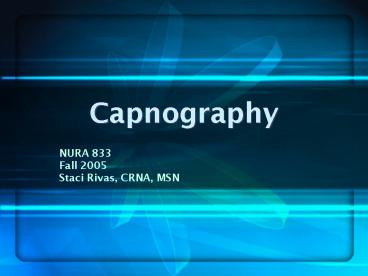Capnography - PowerPoint PPT Presentation
1 / 24
Title:
Capnography
Description:
Term capnography comes from the greek work KAPNOS, meaning smoke. ... cardiac output, distribution of pulmonary blood flow and metabolic activity. ... – PowerPoint PPT presentation
Number of Views:2724
Avg rating:3.0/5.0
Title: Capnography
1
Capnography
- NURA 833
- Fall 2005
- Staci Rivas, CRNA, MSN
2
CAPNOGRAPHY
- Term capnography comes from the greek work
KAPNOS, meaning smoke. - Anesthesia contex inspired and exspired gases
sampled at the Y connector, mask or nasal
cannula. - Gives insight into alterations in ventilation,
cardiac output, distribution of pulmonary blood
flow and metabolic activity.
3
(No Transcript)
4
2 Techniques for Monitoring ETCO2
- 2 methods for obtaining gas sample of analysis
- Mainstream
- Sidestream
- Mainstream (Flow-through or In-line)
- Adapter placed in the breathing circuit
- No gas is removed from the airway
- Adds bulk to the breathing system
- Electronics are vulnerable to mechanical damage
5
Mainstream Analyzer
6
Sidestream Analyzer
7
Sidestream Analyzer
- Sidestream (aspiration)
- Aspirate gas from an airway sampling site and
transport the gas sample through a tube to a
remote CO2 analyzer - Provides ability to analyze multiple gases
- Can use in non-intubated patients
- Potential for disconnect or leak giving false
readings - Withdrawls 50 to 500ml/min of gas from breathing
circuit (most common is 150-200ml/min) - Water vapor from circuit condenses on its way to
monitor - A water trap is usually interposed between the
sample line and analyzer to protect optical
equipment
8
(No Transcript)
9
(No Transcript)
10
Location of Sensor
- The location of CO2 sensor greatly affects the
measurement - Measurement made further from the alveolus can
become mixed with fresh gas causing a dilution of
CO2 values and rounding of capnogram
11
Measurement Techniques
- Infrared analyzer
- Photo acoustic spectrometer
- Raman spectrometer
- Mass spectrometer
12
How ETCO2 Works
- ETCO2 monitoring determines the CO2 concentration
of exhaled gas - Photo detector measures the amount of infrared
light absorbed by airway gas during inspiration
and expiration - CO2 molecules absorb specific wavelengths of
infrared light energy - Light absorption increases directly with CO2
concentration - A monitor converts this data to a CO2 value and a
corresponding waveform (capnogram)
13
The Capnogram Waveform
- Is divided into four distinct phases
14
The Capnogram Waveform
- The first phase (A-B) represents exhalation of
anatomic deadspace - Normally devoid of carbon dioxide
- The second phase (B-C) is present as sharp
upstroke - Determined by the evenness of ventilation and
alveolar emptying - End of Phase II signifies usual end of expiration
15
The Capnogram Waveform
- The third phase (C-D) reflects exhalation of
alveolar gas - Considered expiratory pause
- Point D designates end-tidal CO2 concentration
- The forth phase (D-E) reflects the beginning of
inspiration - Normally will be gases lacking carbon dioxide and
approach zero
16
(No Transcript)
17
(No Transcript)
18
- Connections on sample tubing loose
19
Increasing ETCO2
- Hypoventilation (decrease RR or TV)
- Increase in metabolic rate
- Increase in body temperature
- Malignant hyperthermia
- Release of tourniquet
- Absorption of CO2 from peritoneal insufflation
- Sudden increase in blood pressure
20
Decreasing ETCO2
- Gradual
- Hyperventilation (increase RR or TV)
- Decrease in metabolic rate
- Decrease in body temperature
- Rapid
- Embolism (air or thrombus)
- Sudden hypotension
- Circulatory arrest
21
Increase in Inspired CO2 (Rise in Baseline)
- CO2 absorbent exhausted
- Faulty expiratory valve
- Calibration error in monitor
- Water in analyzer
22
Loss of Plateau /Sloping of ETCO2 Waveform
- Obstruction of expiration (asthma, COPD,
bronchospasm) - A-a gradient is increased
- No plateau is reached prior to next inspiration
- Kinked endotracheal tube
23
Cleft in Phase III of Waveform
- Patient is inspiring during exhalation phase of
mechanical ventilation - Muscle relaxant plasma levels subsiding
- PaCO2 increasing cause spontaneous respiration
- Increasing pain
- In older texts referred to as Curare cleft
24
Cardiogenic Oscillations
- Caused by beating of heart against lungs
- May be seen more as relaxant wears off and tone
returns to chest, abdominal walls and diaphragm - More common in pediatrics because heart takes up
relatively more space in the chest































